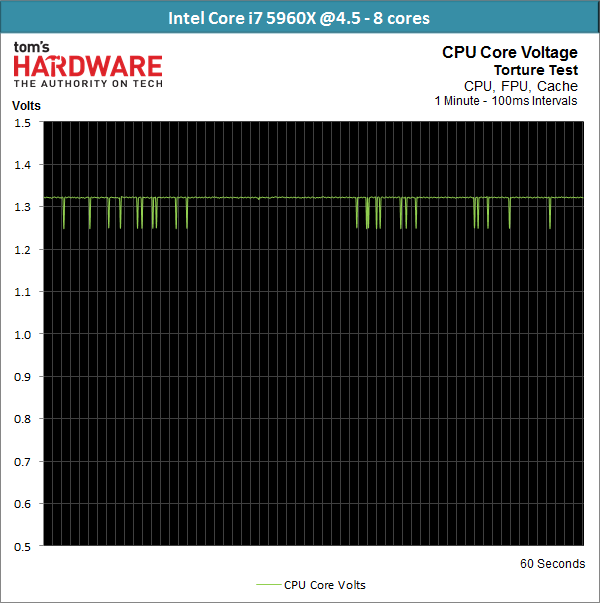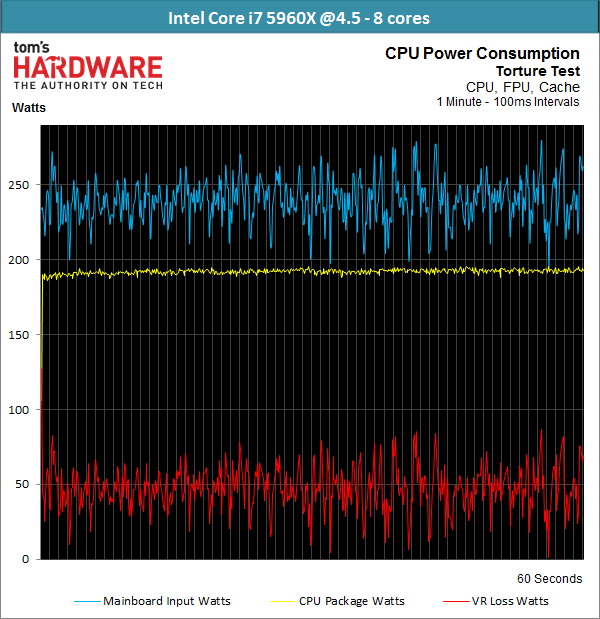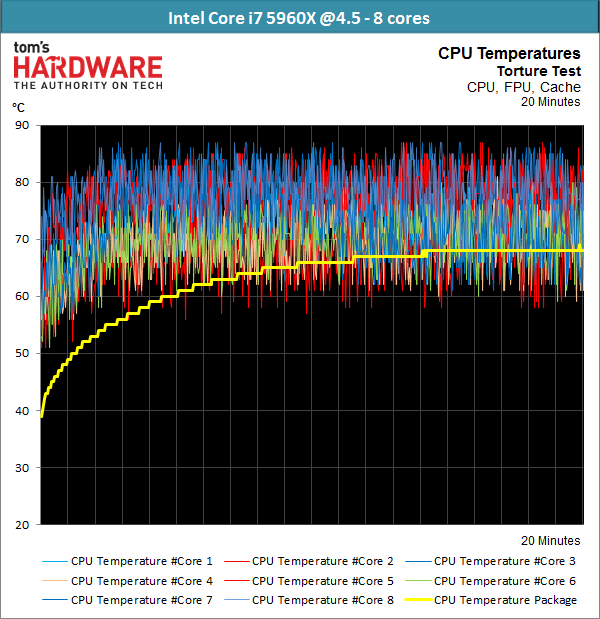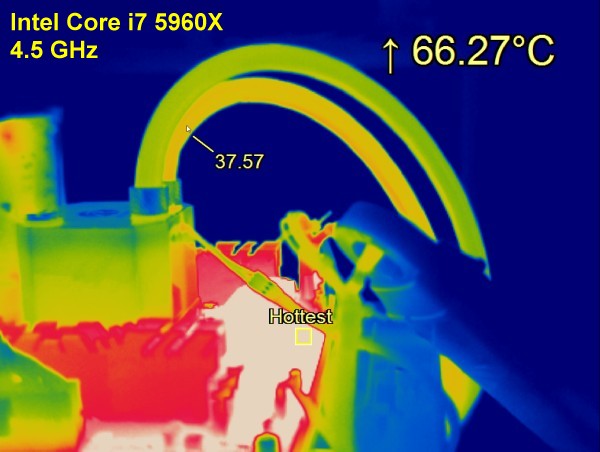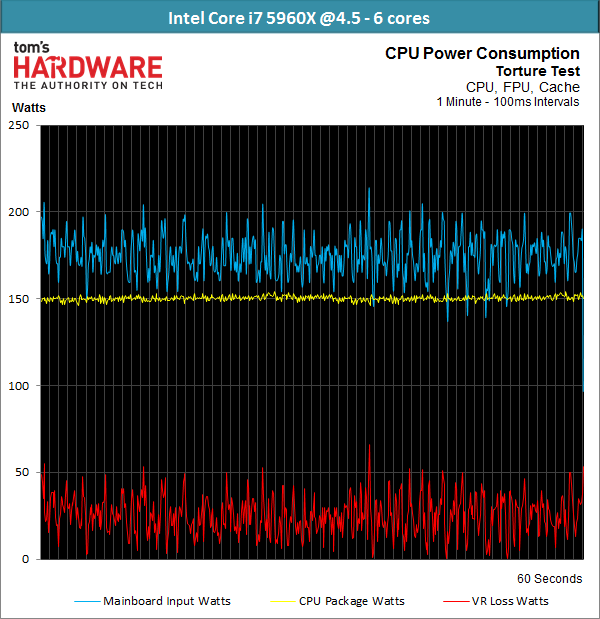Intel Core i7-5960X, -5930K And -5820K CPU Review: Haswell-E Rises
Power, In Depth: Eight and Six Cores at 4.5 GHz
Core Voltage
A measured average voltage of 1.319 V (with the UEFI set to just 1.195 V) shows that you can’t hold back if you want to push Haswell-E a gigahertz beyond its default peak frequency. Expect some extreme power consumption and temperature numbers.
Power Draw
The following graph shows the contrast between what we read from the voltage regulator and EPS connector, making it easy to calculate losses in the process.
At idle, power use is minimal. A 19 W result is ever-so-slightly higher than our reading at 4 GHz. But a 70 W jump under load for an additional 500 MHz tells us we can't expect much more from the Core i7-5960X on water cooling, particularly since the VR-based losses have doubled.
| Power Consumption | Average Idle | Maximum, 100% Load | Average, 100% Load |
|---|---|---|---|
| CPU 12 V In | 24 W | 280 W | 240 W |
| CPU Package | 19 W | 195 W | 192 W |
| VRM Loss | 5 W | 85 W | 48 W |
Temperatures
The temperatures at idle are still nice and low. However, those big fluctuations under load are clear indications that power delivery is becoming more erratic, and throttling is starting to become an issue. For brief periods, our Core i7-5960X cannot sustain 4.5 GHz. It jumps between 4.3 and 4.5 GHz, rather than sacrificing stability.
Here’s the time-lapse video:
| Temperature T | Idle | Maximum, 100% Load | Average, 100% Load (Heated Up) |
|---|---|---|---|
| Core | 27 °C | 87 °C | 75 °C |
| Package | 29 °C | 66 °C | Row 1 - Cell 3 |
| Water (In / Out) | 24 °C / 28 °C | 38 °C | Row 2 - Cell 3 |
| VRM | 34 °C | 67 °C | Row 3 - Cell 3 |
Six Cores At 4.5 GHz
Core Voltage
Does cutting a couple of cores from the equation help bring power back under control? An average core voltage of 1.319 V is just as aggressive, surprisingly enough. Try dialing in something more conservative in the BIOS, though, and you lose stability with this particular sample.
Power Draw
At idle, there's not much difference from the six-core and 4 GHz setting. But a 50 W jump under load (60 W with losses added in) is almost as bad as what we saw from eight cores. You'll have to decide if that's worthwhile for an extra 500 MHz.
Get Tom's Hardware's best news and in-depth reviews, straight to your inbox.
| Power Consumption | Average, Idle | Maximum, 100% Load | Average, 100% Load |
|---|---|---|---|
| CPU 12 V In | 21 W | 214 W | 175 W |
| CPU Package | 17 W | 154 W | 150 W |
| VRM Loss | 4 W | 60 W | 25 W |
Temperatures
Switching off two cores frees up enough thermal headroom to drop maximum temperatures under load by quite a bit. But that doesn't mean you can get away with a cheap air cooler, either. Liquid cooling is the way to go for its ability to quickly draw heat away from the spreader and exhaust that energy out of your chassis by blowing through a big radiator.
| Temperature T | Idle | Maximum, 100% Load | Average, 100% Load (Heated Up) |
|---|---|---|---|
| Core | 27 °C | 82 °C | 68 °C |
| Package | 29 °C | 55 °C | Row 1 - Cell 3 |
| Water (In / Out) | 24 °C / 28 °C | 36 °C | Row 2 - Cell 3 |
| VRM | 34 °C | 54 °C | Row 3 - Cell 3 |
Quick escalation in our power consumption measurements push cooling into the spotlight. We're able to keep a six-core processor running well, but eight cores is pushing it. In spite of the relatively low water temperature, Intel's Core i7-5960X gets so hot that it starts throttling.
Current page: Power, In Depth: Eight and Six Cores at 4.5 GHz
Prev Page Power, In Depth: Eight and Six Cores at 4 GHz Next Page Power, In Depth: CPU Health at 4.8 GHz-
B4vB5 Chris and Igor @ TomsHW,Reply
Bit disappointed to not see a comparison with the Xeon E5-1650v2(or 1660v2), as the 2600 is a bit overkill comparing prices. Some of us just need a workstation with ECC ram and not just a free-for-all(ie someone else is paying) Xeon 2600 fest. -
JamesSneed Out of curiosity why were so many of the gaming tests only done at 2560x1440? Seems like you would be more GPU bound at this resolution. I'm not sure it really matters but I do like gaming at 1080p for the very high frame rates was curious if these would push frame rates higher. Otherwise nice review.Reply -
ohim Reply14063555 said:Affordable 8-cores from Intel are finally coming. Awesome.
1000$ is affordable to you ? :))
14063653 said:Out of curiosity why were so many of the gaming tests only done at 2560x1440? Seems like you would be more GPU bound at this resolution. I'm not sure it really matters but I do like gaming at 1080p for the very high frame rates was curious if these would push frame rates higher. Otherwise nice review.
Though you have a point here, the guy buying such CPUs most likely will game at above 1080p .. but this would have implied using 2 GPUs at least in the test. -
chiefpiggy Why do they call these their "5th generation" of Intel core processors if they're refreshes of the Haswell processors? I get that they have revolutionary technology within but with the release of broadwell so soon I doubt that anyone would buy these processors..Reply -
envy14tpe I need this system to play Minecraft. with that aside, Intel finally has made a jump in i7s value and performance.Reply -
srap "Single-threaded software is so last decade, though."Reply
I have a hunch that we will never see anything like this in the comment sections of AMD reviews. Not sure why :D -
CaptainTom Yeah the real winner of a cpu here is definitely the 5820K. If I were building now, that is what I would use.Reply
